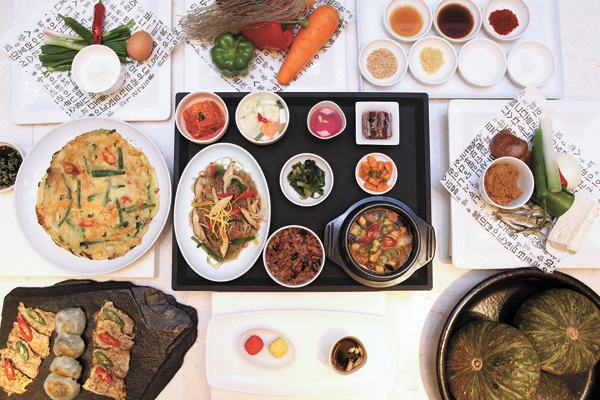Exporting Korean cuisine hotel by hotel

Bae Han-chul (far right), executive chef at Grand InterContinental Seoul Parnas, brings a team of chefs to other InterContinental branches in the world to teach chefs there how to cook Korean food. Provided by the hotel
While many Korean food groups or chefs try to appeal directly to the public at large by introducing a variety of Korean food to them, the local branch of the global hotel chain InterContinental has taken a different approach.
It sends its chefs to its branches in other countries and teaches local chefs how to work with ingredients that Korea is known for. In turn, they can make adaptations of local dishes to please local taste buds.
It is a variation on the bromide of not giving a poor man a fish but teaching him how to fish instead. The InterContinental’s three-year effort has proven effective and far-flung hotels it already visited before are requesting return visits from its Korean chefs.
“It is important to have local chefs work with dishes that are sustainable,” said Bae Han-chul, executive chef at the Grand InterContinental Seoul Parnas, who has been setting the direction for the hotel’s hansik (Korean food) promotion for the past three years.

A variety of Korean dishes including pajeon (pancake made with scallions) are shown with key ingredients and sauces that are often used by chefs at the Grand InterContinental Seoul Parnas.
To show how to get a consistent supply of Korean ingredients, his team usually takes local chefs to markets that have Korean spices and vegetables or provides ways to purchase key sauces that can change the taste of dishes, such as gochujang (hot pepper paste), doenjang (fermented soy bean paste) or soy sauce.
To make purchasing key items easier in the overseas countries, the hotel has joined hands with the Korea Agro-Fisheries and Food Trade Corporation (aT) since 2012. To boost demand for Korean produce, aT has been trying to export more locally grown ingredients and spices.
Usually three or four chefs from the Grand InterContinental Seoul Parnas travel as a team to other hotels all over the world. They have gone to countries nearby such as Malaysia, Vietnam and Singapore, or farther out to the Middle East, Europe and America.
During the visits, chefs work with three or four local chefs through a cooking class. To show how to do plating, chefs also host a gala dinner. They make sure they do a press conference with local media to draw attention to the chance for locals to eat some tasty Korean food.
The team’s most recent trip was to Doha, the capital of Qatar, just last month. During the two-week visit, Korean chefs showed how to make kimchi, gimbap (rice, meat and vegetables wrapped in seaweed) and dakgalbi (stir-fried chicken with vegetables in hot pepper sauce). The menu sounds basic but executive chef Bae has his reasons.
“Even though we have been promoting well-known dishes to the world, there are still many countries and people that are not quite ready to try the new tastes,” said Bae.
“We have narrowed down to 100 recipes we can spread most successfully. We choose them based on whether local chefs can make the best [adaptations] to diversify Korean dishes for their local communities.”
The team of chefs went back to Hong Kong last year, which it first visited in 2012. It has gotten requests to return from two InterContinental branches in Vietnam and Spain.
Hotel ICON in Hong Kong also requested the Korean chefs to teach aspiring chefs who are studying at the School of Hotel and Tourism Management at the Hong Kong Polytechnic University. It will be a three-hour cooking class.
“Some may want to see some drastic changes in our teaching methods as we have developed our programs over a period of years,” said Bae. “But as we work with different hotels in different regions, we have been making rather small changes in details and stick to our original recipes.”
The InterContinental is trying to find which particular dishes work in specific regions. Foods that are chewier such as tteobokki (spicy rice cake) are more popular in Southeast Asia, while steamed butterfish with spicy sauce was particularly popular in India. Barbeque dishes are more popular in Europe.
Korean food made with ingredients one can find anywhere are also popular for the convenience. Pajeon (pancake with scallions), and gyeranjjim, often referred to as Korean-style egg souffle, are sought after in many regions.
Bae also hopes that his attempt to teach chefs will encourage them to pay a visit to Korea, looking for suitable plates and dishes to make better presentations of Korean dishes.
“Instead of bringing everything overseas, they can come to Korea to gain expertise,” said the chef.
BY LEE SUN-MIN [lee.sunmin@joongang.co.kr]










with the Korea JoongAng Daily
To write comments, please log in to one of the accounts.
Standards Board Policy (0/250자)